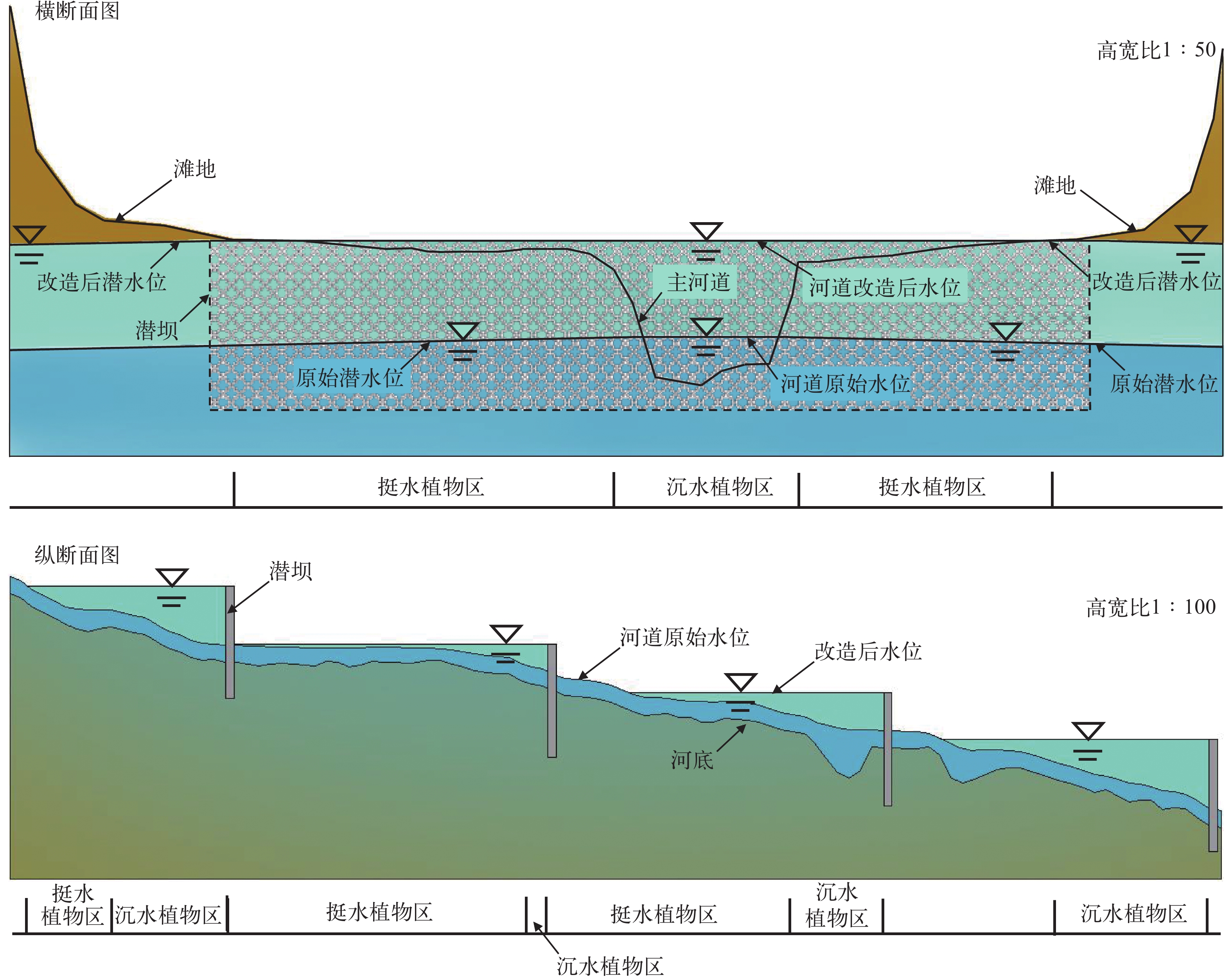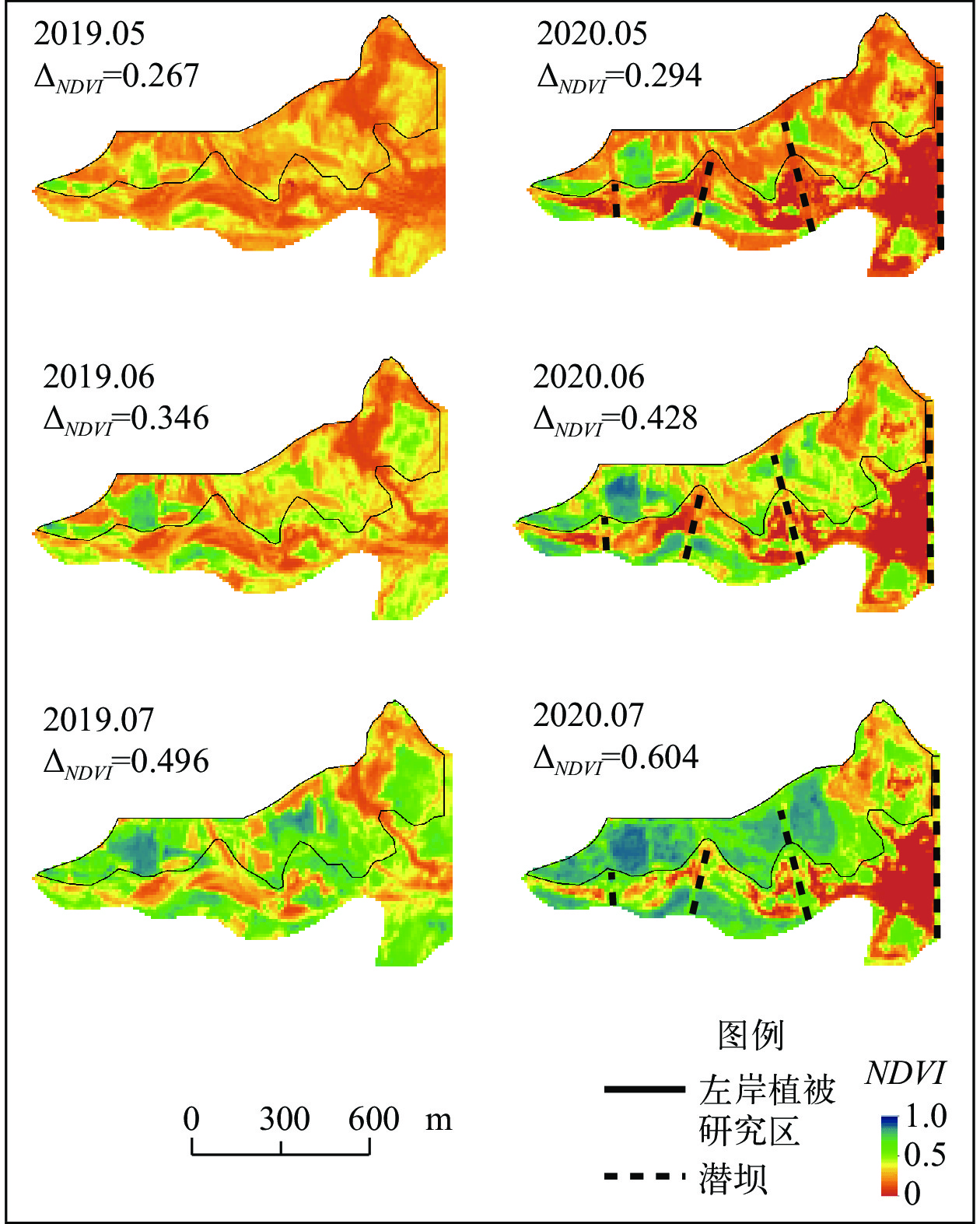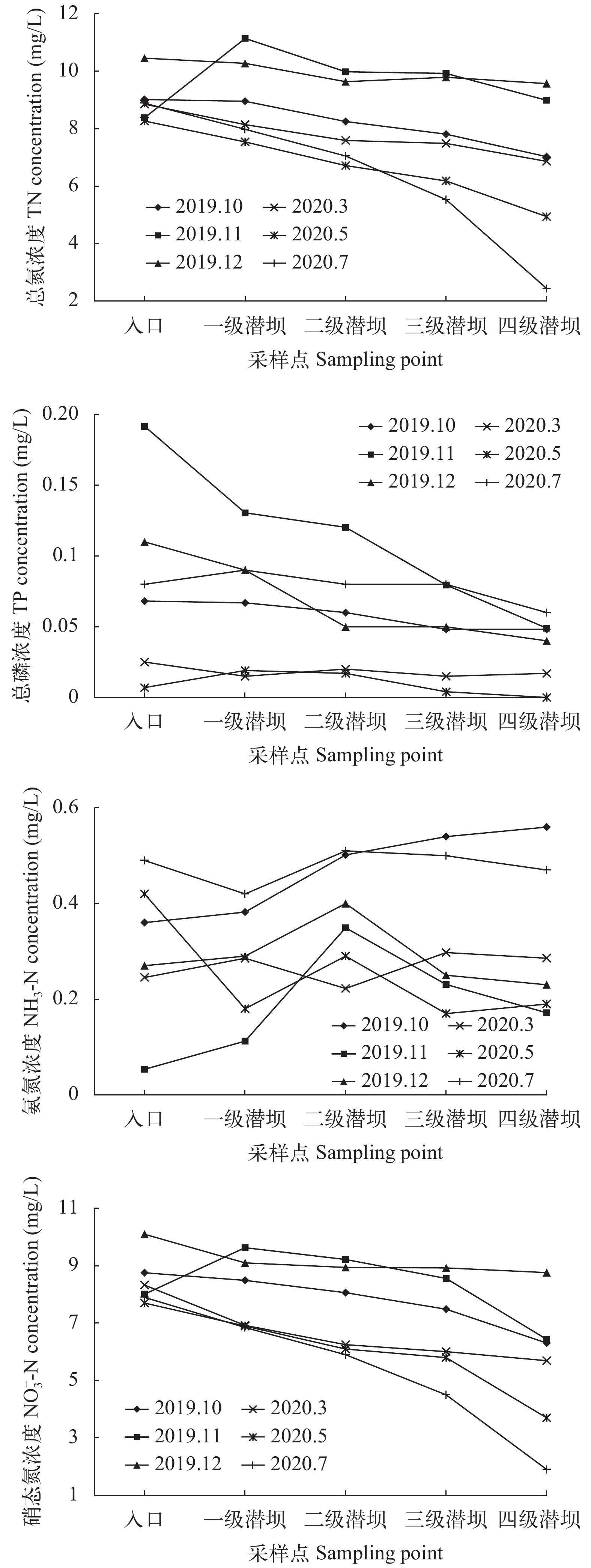HYDROLOGICAL IMROVEMENT AND ENVIRONMENTAL EFFECT OF TRANSFORMING HYDROLOGICAL ELEMENTS OF THE ESTUARINE FLUCTUATION ZONE
-
摘要: 文章针对水库河口消落区普遍存在的污染物削减能力弱问题, 提出采用多级潜坝改造水文条件, 构建表面流人工湿地, 提升对径流净化效能的改造技术, 并以碧流河水库八家河河口消落区为对象开展研究, 分析改造工程前后区域水质变化。结果表明: 随着水文条件的改变, 挺水植物在没有人为干预的条件下生长状态良好, 滩地植被条件也得到了明显改善; 水淹区域本底污染物析出对湿地水质具有明显影响; 研究区域对径流中TN和
${\rm{NO}}^-_3$ -N的去除效率在改造后得到了有效提高, 对TN和${\rm{NO}}^-_3$ -N的最高去除率分别达到72.6%和76.0%, 但是对TP和NH3-N去除效率的提升不明显。水文条件的改造能够有效提高水库河口消落区净化能力, 有效削减流域入库污染物。Abstract: Estuarine fluctuation zone is the key area for pollutant reduction in tributaries in reservoir. Affected by runoff scouring, river channel downcutting is a common problem in estuarine fluctuation zone, which makes the low purification efficiency of the runoff. Aimed at the weak ability of pollutant reduction of the estuarine fluctuation zone, the technology of improving purification efficiency by transforming hydrological elements with multi-stage submerged dam, which can form a surface flow constructed wetland, was proposed. The estuarine fluctuation zone of the Bajia River in the Biliuhe Reservoir was taken as a case study in this paper. By comparing the water quality and Normalized Difference Vegetation Index (NDVI), acquired through on-site monitoring and satellite imagery of Sentinel-2A and the situation before and after the construction, the influence of the project was analyzed. The water surface area and the water level as well as the hydraulic retention time in the estuary were all effectively improved. With the change of hydrological elements, the emergent plants grew well without human intervention, while the vegetation on the floodplain was significantly improved due to the increase of underground water level. Due to the influence of flooding, the pollutants on the land were released. The precipitation of the original pollutants in the flooded area has a significant impact on wetland water quality. The maximum removal rates of TN and${\rm NO}_3^- $ -N reached 72.61% and 75.95% in July 2020, while those in October 2019 were 22.06% and 27.95%, respectively. As a whole, the removal rates were good in surface flow constructed wetlands in China, while the improvement of TP and NH3-N removal efficiencies was not obvious, which may be caused by the precipitation of original pollutants. The hydrological elements transformation technology can effectively improve the purification capacity of the estuarine fluctuation zone and promote the reduction of pollutants in the basin. -
水库河口消落区是支流与水库的过渡地带, 具有陆地和水域的双重属性, 是一种特殊形式的湿地。作为支流入库前最后的流经区, 河口消落区是支流入库污染物削减的关键区域。受径流冲刷影响, 河口消落区普遍存在河道下切问题, 落干期支流径流在河口消落区以主河道过流为主[1], 河流流速快、水力停留时间短。对于北方水库而言, 支流径流量主要集中在洪水期, 大部分河道和滩地多数时间处于落干闲置状态, 河道对径流较低的净化效率限制了河口消落区对入库径流污染物的削减作用。通过有效手段充分利用河道和滩地空间, 强化河口消落区对径流的净化能力, 对削减流域污染物输入, 改善水库水质具有至关重要的意义。
人工湿地因其较高的处理效率、良好的生态效应和较低的处理成本[2], 已经被广泛应用于河流进入湖库污染物的削减中。翟玥[3]、陈佳秋等[4]和修春海等[5]分别对洱海、白洋淀和玉清湖水库支流河口湿地的研究表明, 人工湿地对河流进入湖库径流中的污染物具有良好的削减作用, 但在现有研究中, 湿地多建在河口旁侧并通过引水实现对径流的净化, 从而降低洪水对湿地运行的影响, 这需要较大的额外空间, 而直接利用河口原有河道和滩地的人工湿地研究较少。
本文以碧流河水库八家河河口消落区为研究对象, 开展通过设置多级潜坝而改变水文条件, 构建表面流人工湿地, 提升水库河口消落区净化效能的技术体系研究, 分析工程前后区域植被的变化和对径流的净化效果, 以期为类似工程提供工程示范和理论支持。
1. 材料与方法
1.1 河口消落区的水文条件改造技术
水库河口消落区水文条件改造技术是在河口消落区内设置阻水建筑拦蓄径流, 通过抬高水位扩大水面面积, 减缓水流流速, 提高水力停留时间改变主河道的集中过流造成的不利水文条件。随着水文条件的改变, 在不进行人工干预的前提下, 湿地内的水生生物群落也将逐渐形成, 发挥其水质净化功能和生态效应[6], 从而形成表面流人工湿地。表面流人工湿地不存在填料堵塞的问题, 生态效益更高、适应性更强[7]、洪水后维护成本也更低, 将其应用于河口消落区具有更好的适用性。随着河道水位提高, 滩地的地下潜水也会随之上涨, 滩地植被条件也会随之改善。
采用稍高出滩地的潜坝拦蓄地表径流能够减少洪水对建筑稳定性的影响。潜坝也需要对地下渗流进行一定程度的拦截, 一方面防止过多来水经由渗流流失, 另一方面能够避免过度的地下渗流对基础稳定性造成影响。为了适应地形较大的高程变化范围, 采用多级潜坝分级拦蓄径流, 最终在河口消落区形成串联的多级表面流人工湿地(图 1)。湿地中水深的差异会促使水生植物自然形成挺水植物和沉水植物的组合, 这也有利于提高湿地对污染物的去除效率[8]。根据水深和植物种类不同, 湿地可以划分为两个区域, 水深较大的区域即各级湿地下游段主河道和靠近坝前的部分滩地为沉水植物区, 其他水深较小的区域即大部分滩地和各级湿地上游主河道为挺水植物区。
1.2 研究区域概况
碧流河水库位于大连市北部, 总库容9.3×108 km3, 日供水量超过1×106 m3/d, 是大连市最主要的水源地。水库水质总体达到Ⅱ类标准, 但也存在总氮常年超标, 铁、锰等部分指标区域性、季节性超标等问题[9]。碧流河水库流域年降水量变化幅度大[10], 丰水年和枯水年相差3倍以上, 这使得水库水位年际波动大, 消落区经常出现连续多年落干的情况。
八家河位于碧流河水库右岸, 是水库的第三大支流, 流域面积113.7 km2, 多年平均径流量约43500 m3/d。八家河流域内污染源主要是农田退水、农村生活污水、畜禽养殖等农业非点源污染, 水质总体达到地表Ⅲ类水质标准, 但总氮超标严重[11]。八家河河口消落区平坦开阔, 两侧为山地, 上游段左岸分布有村庄, 上游和中游部分滩地在落干期被居民侵占用于种植玉米、大豆等农作物。研究区域内土壤以砾砂为主, 部分区域存在卵石夹层, 径流在落干期的冲刷在河口区内形成了较为稳定的主河道, 经过多年的冲刷, 尤其是在2013—2019年经历了连续多年的落干期, 河道下切问题严重, 主河道与两岸滩地地面高差普遍在1 m以上, 主河道内日常水深普遍在0.5 m以下, 水面最大宽度16.2 m。2019年冬季对潜水位的调查显示, 滩地潜水深度在地面以下2.5 m以内, 潜水位在河道两侧与河道水面高程基本一致, 随着与河道距离的增加, 部分断面潜水位逐渐降低, 部分断面可能受两侧山谷地下水补给影响潜水位有所升高, 变化幅度0.5—1 m。在中游段的左岸和下游段的左右两岸分别有一条支流汇入, 三条支流除洪水期外流量极小, 部分时间处于断流状态。
1.3 八家河河口湿地关键参数
流量及水质 受流域降水规律影响, 八家河流量在年内和年际波动较大, 设计流量采用八家河多年平均径流量43500 m3/d。设计进水水质采用上游断面2018年监测数据四舍五入至十分位后数值, 八家河径流总磷(TP)和氨氮(NH3-N)能够达到地表Ⅱ类水质标准, 但总氮(TN)超过地表Ⅴ类水质标准1.5倍, 改造后的湿地对污染物具有一定的削减效果, 但由于原有TN浓度较高, 设计出水水质的TN仍达不到地表Ⅴ类水质标准(表 1)。
表 1 湿地设计进出水水质Table 1. The design influent and effluent water quality of the wetlandTN TP NH3-N 设计进水水质
Design inlet water quality (mg/L)5.00 0.10 0.30 设计出水水质
Design effluent quality (mg/L)3.00 0.07 0.15 设计去除率
Design removal rate (%)40.0 30.0 50.0 污染物削减负荷
Pollutant reduction load (g/m2/d)0.43 0.01 0.03 潜坝参数 水文条件的改造主要依靠潜坝实现, 潜坝的布置需要综合考虑湿地效果、洪水影响和水库水位涨落的影响[12]。在八家河河口消落区共设置四级潜坝(图 2), 坝顶高程依次为68.1、67.0、65.5和64.5 m。潜坝地面以上部分采用叠砌的格宾网箱结构, 内置竖向土工膜进行防渗, 根据高渗透性的砾砂层和卵石层的分布深度确定土工膜截潜深度4 m。湿地内植物由其自然生长, 不进行人工干预。
湿地参数变化 八家河河口消落区改造后, 水位最大提高2 m, 湿地总水面面积增加15.8倍, 水力停留时间增加38倍, 表面水力负荷降低93.9%(表 2)。
表 2 改造前后主要参数对比Table 2. Comparison of main parameters before and after transformation水面面积Water surface area (×104 m2) 水力停留时间
Hydraulic retention
time (d)水力负荷
Hydraulic load
[m3/(m2·d)]一级湿地
First-stage
wetland二级湿地
Second-stage
wetland三级湿地
Third-stage
wetland四级湿地
Fourth-stage
wetland合计
Total改造前Before transforming 0.14 0.16 0.23 0.67 1.20 0.11 3.63 改造后
After transforming2.99 1.67 4.40 11.15 20.21 4.29 0.22 改善比例 Improvement ratio (%) 2040 948 1810 1560 1580 3800 93.9 1.4 分析方法
地表分析方法 本研究选用归一化植被指数NDVI(Normalized Difference Vegetation Index)作为反映区域植被和水面变化的参数。研究使用由欧洲航天局提供的Sentinel-2多光谱成像卫星影像数据, 覆盖13个光谱段, 地面最高分辨率10 m, 单颗卫星重访周期10d, 两颗卫星互补周期5d[13]。将2019年和2020年的5至7月作为研究时段, 选择每月最接近15日的有效影像用于分析。采用SNAP软件对影像进行预处理, 将研究区域各波段的分辨率统一为10 m, 使用ENVI 5.1软件将近红外波段、红光波段和绿光波段合成为标准假彩色遥感影像, 计算各象元NDVI, 计算公式如下[14]:
$NDVI=\frac{I_{\rm{NIR}}-I_{\rm{R}}}{I_{\rm{NIR}}+I_{\rm{R}}} $


式中, NDVI为各象元归一化植被指数; INIR、IR分别为各象元近红外波段和红光波段的反射率。
This page contains the following errors:
error on line 1 at column 1: Start tag expected, '<' not foundBelow is a rendering of the page up to the first error.
2. 结果
2.1 河口消落区NDVI变化
2019年和2020年的5—7月研究区域卫星影像图如图 3所示, NDVI如图 4所示。由卫星影像可以看出, 2020年研究区域各月植被覆盖条件好于2019年同期。2019年5—7月, 研究区域象元最低NDVI分别为0.01、0.08和0.10, 均大于0且呈逐渐增长趋势, 而被水覆盖区域的NDVI一般小于0, 这表明改造前研究区域内没有地表全部为明水面的象元存在, 而2019年河道内基本没有水生植物, 由此可见, 改造前研究区内河道宽度窄, 水面面积小, 研究区域内没有被水面完全覆盖的象元。2020年5—7月, 研究区域均存在较多数量的象元NDVI低于0, 随着时间的推移, 挺水植物区内NDVI低于0的象元数量逐渐减小。这表明改造工程显著增加了水面面积, 随着水文条件的改变, 在没有人工种植的情况下, 挺水植物区内的挺水植物长势良好并覆盖了水面。
在改造工程后, 研究区域陆地整体的NDVI较改造前有了较为明显的提升, 左岸滩地植被研究区2020年5月、6月和7月的NDVI平均值较2019年同期分别增长10.1%、23.7%和21.8%, 这表明改造工程抬高潜水位对滩地植被也具有较好的改善效果。
2.2 改造前后水质变化
水质监测结果如图 5。在监测时段内, 进水的TN浓度均高于设计进水浓度, 其中, 冬季TN高于其他季节。八家河河口消落区在改造前对径流TN也具有一定的净化作用, 2019年10月湿地具有最高去除率为22.1%。在改造工程后, 2020年3月湿地对TN去除率为22.5%, 与2019年10月相当。2020年5月至7月湿地对TN的去除率逐步增加, 7月去除率最高为72.6%。
进水TP浓度在各月均能达到地表Ⅲ类水质标准, 冬季TP浓度高于其他季节, TP去除率也更高。在改造工程前, TP浓度延程降低, 2019年11月的去除率最高, 达到74.4%; 在改造工程后, 湿地对于TP的去除率较低, 去除率除5月出水浓度低于检测限去除率记为100%外, 其他两个月份去除率均在30%左右。在前三级湿地, TP在不同时段均出现了某一级湿地出水浓度高于进水现象。
河流NH3-N浓度总体较低, 能够达到地表Ⅲ类水质标准, 但区域对其去除率低。2019年10月和11月, 出水NH3-N浓度高于进水, 12月去除率为14.8%。在改造工程后, 河口区对NH3-N的去除效果有所提高, 但总体去除率仍较低。在2020年3月出水浓度稍高于进水浓度, 2020年5月和7月去除率分别为54.8%和4.1%。在前三级湿地, NH3-N在部分时段出现了某一级湿地出水浓度高于进水的现象。
This page contains the following errors:
error on line 1 at column 1: Start tag expected, '<' not foundBelow is a rendering of the page up to the first error.
3. 讨论
3.1 河口消落区本底污染物对湿地运行初期去除率的影响
改造工程对于研究区TP和NH3-N去除效率改善效果并不显著。监测时段内湿地延程的TP和NH3-N浓度出现了某一级湿地出水浓度高于进水的现象, 其中, NH3-N浓度波动尤为明显。水体中的TP和NH3-N在没有外来输入的条件下很难大量增加[15], 由此推断, 这很可能是受外源污染物输入的影响。采样期间, 支流流量均较小且TP和NH3-N浓度也不高, 支流的汇入不会对水体TP和NH3-N浓度产生较大影响, TP和NH3-N浓度增长很可能受河口消落区本底污染物影响。NH3-N浓度在改造工程前后均出现了某一级湿地出水浓度高于进水的现象, 改造工程前监测时段为秋冬季, 植物枯萎和腐烂分解的过程中会产生大量NH3-N[16], 其升高很可能受此影响。在改造工程后, 水体淹没促使地表植物残体、土壤和地表家畜粪便中的NH3-N析出进入水体。其中, 增长幅度最大的二级湿地也是两岸滩地植物和农田最为集中的河段。相比于NH3-N, 磷更多附着在颗粒物上, 这可能是改造前日常析出对径流影响较小的原因。在改造工程后, 地表植物残体、土壤和地表家畜粪便中的磷在水淹条件下进入水体造成了部分湿地出水浓度高于进水浓度, 但总体波动较小。
由此可以推断, 在运行初期, 淹没区域本底污染物析出会对湿地水质产生明显影响, 湿地对污染物的实际去除效果需要进一步长时间的连续监测才能最终确定。这也表明, 河口消落区水淹和秋冬季植物腐烂的过程中会向水库水体中释放大量污染物, 在库区的水质管理中应及时收割消落区植物, 加强消落区管理。
3.2 改造工程对污染物去除率的影响
This page contains the following errors:
error on line 1 at column 1: Start tag expected, '<' not foundBelow is a rendering of the page up to the first error.
4. 结论
This page contains the following errors:
error on line 1 at column 1: Start tag expected, '<' not foundBelow is a rendering of the page up to the first error.
-
表 1 湿地设计进出水水质
Table 1 The design influent and effluent water quality of the wetland
TN TP NH3-N 设计进水水质
Design inlet water quality (mg/L)5.00 0.10 0.30 设计出水水质
Design effluent quality (mg/L)3.00 0.07 0.15 设计去除率
Design removal rate (%)40.0 30.0 50.0 污染物削减负荷
Pollutant reduction load (g/m2/d)0.43 0.01 0.03 表 2 改造前后主要参数对比
Table 2 Comparison of main parameters before and after transformation
水面面积Water surface area (×104 m2) 水力停留时间
Hydraulic retention
time (d)水力负荷
Hydraulic load
[m3/(m2·d)]一级湿地
First-stage
wetland二级湿地
Second-stage
wetland三级湿地
Third-stage
wetland四级湿地
Fourth-stage
wetland合计
Total改造前Before transforming 0.14 0.16 0.23 0.67 1.20 0.11 3.63 改造后
After transforming2.99 1.67 4.40 11.15 20.21 4.29 0.22 改善比例 Improvement ratio (%) 2040 948 1810 1560 1580 3800 93.9 -
[1] 朱晨莹. 水库入流消落区环境特征及水质净化技术研究 [D]. 大连: 大连理工大学, 2019: 8. Zhu C Y. Study on environmental characteristics and water purification technology of drawdown area in river flow into reservoir [D]. Dalian: Dalian University of Technology, 2019: 8.
[2] 孙园, 魏心雨, 丁怡. 人工湿地在修复富营养化水体中的应用及研究进展 [J]. 工业水处理, 2021, 41(2): 8-14. Sun Y, Wei X Y, Ding Y. Application and research progress of constructed wetland in restoration of eutrophic water body [J]. Industrial Water Treatment, 2021, 41(2): 8-14.
[3] 翟玥. 洱海流域入湖河流污染分析及人工湿地处理技术研究 [D]. 上海交通大学, 2012: 35-41. Zhai Y. Study on polluion of inflow rivers in the lake erhai watershed and constructed wetland techonlogy [D]. Shanghai: Shanghai Jiao Tong University, 2012: 35-41.
[4] 陈佳秋, 陈美玲, 张轩波, 等. 雄安新区府河河口湿地修复工程 [J]. 湿地科学与管理, 2020, 16(4): 4-8. doi: 10.3969/j.issn.1673-3290.2020.04.01 Chen J Q, Chen M L, Zhang X B, et al. The restoration project of Fuhe River Estuarine Wetland in Xiong’an New Area [J]. Wetland Science & Management, 2020, 16(4): 4-8. doi: 10.3969/j.issn.1673-3290.2020.04.01
[5] 修春海, 焦盈盈, 武道吉. 表流人工湿地改善玉清湖入库水水质的研究 [J]. 中国给水排水, 2008, 24(13): 100-102+105. Xiu C H, Jiao Y Y, Wu D J. Surface-flow constructed wetland for improvement of water quality into Yuqing Lake Reservoir [J]. China Water & Wastewater, 2008, 24(13): 100-102+105.
[6] 杜彦良, 张双虎, 王利军, 等. 人工湿地植物水质净化作用的数值模拟研究 [J]. 水利学报, 2020, 51(6): 675-684. Du Y L, Zhang S H, Wang L J, et al. Numerical simulation of water purification effects of aquatic plant in artificial surface flow wetland [J]. Journal of Hydraulic Engineering, 2020, 51(6): 675-684.
[7] Katz G L, Stromberg J, Denslow M W. Streamside herbaceous vegetation response to hydrologic restoration on the San Pedro River, Arizona [J]. Ecohydrology, 2009, 2(2): 213-225. doi: 10.1002/eco.62
[8] 陈进军, 郑翀, 郑少奎. 表面流人工湿地中水生植被的净化效应与组合系统净化效果 [J]. 环境科学学报, 2008, 28(10): 2029-2035. Chen J J, Zheng C, Zheng S K. Pollutant purification performance of a surface flow constructed wetland planted with different aquatic macrophytes and their combination [J]. Acta Scientiae Circumstantiae, 2008, 28(10): 2029-2035.
[9] Wang T X, Xu S G, Liu J W. Analysis of accumulation formation of sediment contamination in reservoirs after decades of running: a case study of nitrogen accumulation in Biliuhe reservoir [J]. Environmental Science and Pollution Research, 2018, 25(9): 9165-9175. doi: 10.1007/s11356-018-1232-y
[10] Qin G, Liu J, Wang T, et al. An integrated methodology to analyze the total nitrogen accumulation in a drinking water reservoir based on the SWAT model driven by CMADS: a case study of the Biliuhe reservoir in Northeast China [J]. Water, 2018, 10(11): 1535. doi: 10.3390/w10111535
[11] 李懿健. 辽东半岛河流水环境调查分析及治理模式研究 [D]. 大连: 大连理工大学, 2021: 39, 40. Li Y J. The Investigation and analysis of river water environment and the study of management mode in Liaodong Peninsula [D]. Dalian: Dalian University of Technology, 2021: 39, 40.
[12] 王瑞奇. 八家河入库段水质净化生态工程技术研究 [D]. 大连: 大连理工大学, 2018: 28-30. Wang R Q. Study on ecological engineering technology of water purification in the inflow section of Bajiahe River [D]. Dalian: Dalian University of Technology, 2018: 28-30.
[13] 李煜, 李崇贵, 刘思涵, 等. 应用哨兵2A多时相遥感影像对树种的识别 [J]. 东北林业大学学报, 2021, 49(3): 44-47+51. Li Y, Li C G, Liu S H, et al. Tree species recognition with sentinel-2A multitemporal remote sensing image [J]. Journal of Northeast Forestry University, 2021, 49(3): 44-47+51.
[14] 杨达, 易桂花, 张廷斌, 等. 青藏高原植被生长季NDVI时空变化与影响因素 [J]. 应用生态学报, 2021, 32(4): 1361-1372. doi: 10.13287/j.1001-9332.202104.014 Yang D, Yi G H, Zhang Y B, et al. Spatiotemporal variation and driving factors of growing season NDVI in the Tibetan Plateau, China [J]. Chinese Journal of Applied Ecology, 2021, 32(4): 1361-1372. doi: 10.13287/j.1001-9332.202104.014
[15] 谢文理, 田颖, 祁红娟, 等. 太滆运河氨氮污染时空特征及来源研究 [J]. 安徽农业科学, 2018, 46(22): 55-57. Xie W L, Tian Y, Qi H J, et al. Study on spatial-temporal features and source of ammonia-nitrogen pollution of Taige Canal [J]. Journal of Anhui Agricultural Sciences, 2018, 46(22): 55-57.
[16] 林志军. 三种挺水植物腐烂分解及其污染物释放规律的研究 [D]. 镇江: 江苏大学, 2017: 33-35. Lin Z J. A Study on the decomposition of three kinds of emerged plants and the release of pollutants [D]. Zhenjiang: Jiangsu University, 2017: 33-35.
[17] Gunes K, Tuncsiper B, Ayaz S, et al. The ability of free water surface constructed wetland system to treat high strength domestic wastewater: a case study for the Mediterranean [J]. Ecological Engineering, 2012(44): 278-284. doi: 10.1016/j.ecoleng.2012.04.008
[18] Sehar S, Naz I, Khan S, et al. Performance evaluation of integrated constructed wetland for domestic wastewater treatment [J]. Water Environment Research, 2016, 88(3): 280-287. doi: 10.2175/106143016X14504669767814
[19] 付新喜, 吴晓芙, 陈永华, 等. 季节变化对组合湿地污水处理系统净化力的影响 [J]. 中南林业科技大学学报, 2017, 37(9): 124-128. Fu X X, Wu X F, Chen Y H, et al. Effect of seasonal changes on pollutant removal rate of a constructed wetland system established for treatment of municipal sewage [J]. Journal of Central South University of Forestry & Technology, 2017, 37(9): 124-128.
[20] 周林飞, 邹飞, 李颖卓. 石佛寺表面流人工湿地对辽河水质净化效果研究 [J]. 中国农村水利水电, 2014(2): 1-5+12. Zhou L F, Zou F, Li Y Z, et al. The purification effect of the Liaohe River water quality on shifosi surface flow constructed wetland [J]. China Rural Water and Hydropower, 2014(2): 1-5+12.
[21] 张华, 孙盛. 我国表面流人工湿地系统对污染物去除效果研究现状 [J]. 广东林业科技, 2015, 31(4): 121-127. Zhang H, Sun S. Review of surface flow constructed wetland removal of contaminants in China [J]. Guangdong Forestry Science and Technology, 2015, 31(4): 121-127.
[22] Chavan P V, Dennett K E, Marchand E A, et al. Evaluation of small-scale constructed wetland for water quality and Hg transformation [J]. Journal of Hazardous Materials, 2007, 149(3): 543-547. doi: 10.1016/j.jhazmat.2007.06.077
[23] Brisson J, Chazarenc F. Maximizing pollutant removal in constructed wetlands: should we pay more attention to macrophyte species selection [J]? Science of the Total Environment, 2009, 407(13): 3923-3930. doi: 10.1016/j.scitotenv.2008.05.047
[24] WEI D, Singh R P, Li Y, et al. Nitrogen removal efficiency of surface flow constructed wetland for treating slightly polluted river water [J]. Environmental Science and Pollution Research, 2020, 27(20): 24902-24913. doi: 10.1007/s11356-020-08393-0
[25] Wang W, Gao J, Guo X, et al. Long-term effects and performance of two-stage baffled surface flow constructed wetland treating polluted river [J]. Ecological Engineering, 2012(49): 93-103. doi: 10.1016/j.ecoleng.2012.08.016
[26] 马义源. 济宁市老运河表流人工湿地生态效能研究 [D]. 济南: 山东建筑大学, 2021: 28. Ma Y Y. Study on ecological efficiency of surface flow constructed wetland in the Old Canal in Jining [D]. Jinan: Shandong Jianzhu University, 2021: 28.
-
期刊类型引用(1)
1. 刘倩,赵娥,王克焕,熊雄,吴辰熙. 青藏高原天然湿地水环境特征和水质净化能力分析. 水生生物学报. 2022(12): 1797-1806 .  本站查看
本站查看
其他类型引用(0)






 下载:
下载:



